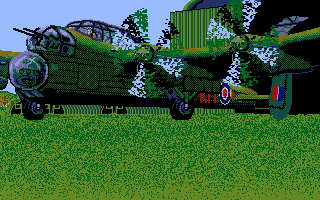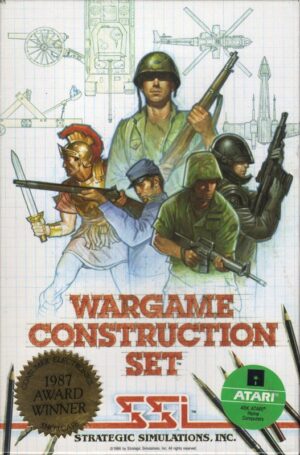Retro Replay Review
Gameplay
In Lancaster, you step into the role of a Lancaster bomber’s gunner during intense World War II missions. The game splits each bombing run into two distinct segments, offering variety and tension. In the first segment, you assume a cockpit view where your primary objective is to maintain aerial superiority.
During this cockpit-view section, you use the mouse to maneuver a crosshair, targeting incoming enemy fighters and anti-aircraft fire. The controls are intuitive, allowing both novices and seasoned sim pilots to quickly engage threats. Each successful shot brings a rush of adrenaline, while each near miss reminds you of the stakes at hand.
Once you clear the skies or fend off enough attackers, the game transitions to a top-down perspective. Here, you take control of the entire bomber, steering it over the target zone. The mouse-driven navigation feels responsive, whether you’re weaving through flak or lining up for the perfect bomb run.
Graphics
Lancaster’s visual presentation captures the era’s gritty realism without demanding a top-of-the-line rig. The bomber model is detailed, from riveted fuselage panels to the swiveling gun turret. Lighting effects simulate dawn raids or twilight missions, casting dramatic shadows across the planes and landscape.
The cockpit-view segment showcases dynamic weather and smoke trails, adding depth to every dogfight. Clouds billow realistically, and enemy aircraft flare and burn when shot down, offering satisfying visual feedback. On the ground, anti-aircraft bursts punctuate the sky with bright flashes and billowing black smoke.
Switching to the top-down view, you’ll notice a clear delineation between farmland, industrial complexes, and military installations. Targets are highlighted subtly, ensuring you know where to drop your limited bombs. The perspective shift is seamless, maintaining immersion while delivering vital tactical information.
Story
While Lancaster doesn’t weave an intricate character-driven narrative, it does ground you firmly in WWII’s strategic bombing campaigns. Each mission briefing outlines the historical context, from crippling industrial sites to supporting allied ground advances. This backdrop gives your objectives real weight and historical significance.
The absence of scripted dialogues or cinematic cutscenes focuses your attention on the barber-pole propellers, the distant rumble of engines, and the relentless anti-aircraft fire below. You become part of a collective crew effort, relying on your gunners, pilots, and navigators to bring everyone home safely.
For players seeking a personal storyline or deep character arcs, Lancaster’s approach may feel minimalist. However, this streamlined narrative keeps gameplay front and center, emphasizing the tangible outcomes of each mission. Success or failure resonates more through changing strategic landscapes than through scripted drama.
Overall Experience
Lancaster strikes a balance between accessible arcade-style shooting and authentic bomber simulation. The dual-segment bombing runs keep gameplay fresh, alternating between high-intensity dogfights and precision bombing tasks. Each mission feels like a test of both reflexes and strategic thinking.
Despite its focused scope, the game delivers enough variety through different mission types, weather patterns, and enemy formations. The limited bomb loadouts add a layer of resource management, forcing you to prioritize high-value targets and adapt on the fly to shifting circumstances.
In the end, Lancaster offers a compelling snapshot of the bomber gunner’s experience in WWII. With crisp controls, evocative visuals, and a documentary-like approach to historical missions, it’s a solid choice for flight-sim enthusiasts and casual players alike. Whether you’re diving into your first sortie or looking to refine your bombing technique, Lancaster provides a rewarding challenge worth revisiting.
 Retro Replay Retro Replay gaming reviews, news, emulation, geek stuff and more!
Retro Replay Retro Replay gaming reviews, news, emulation, geek stuff and more!









Reviews
There are no reviews yet.